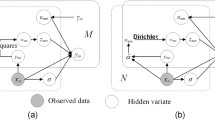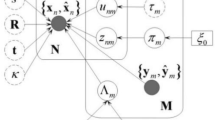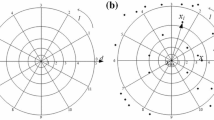Abstract
Aiming to improve the performance of non-rigid point set registration, this paper proposes a probabilistic method with student’s t mixture model (SMM) under the Bayesian inference framework. In the proposed method, non-rigid point set registration is formulated as a probabilistic density estimation problem with SMM in Bayesian manner. In order to improve the robustness to rotation degradation, we consider the rotation transformation in modeling non-rigid displacement. Then, the hierarchical Bayesian model of non-rigid point set registration is constructed, and approximate posteriors of model parameters are derived by the variational Bayesian Expectation Maximization update rules, which can provide the uncertainty measurements of parameters. For those parameters without priors imposed, the updating formulae are obtained by directly maximizing variational lower bound. Finally, an empirical coarse-to-fine algorithm is designed to perform non-rigid point set registration process. The experimental results demonstrate that the proposed method can achieve higher matching performance compared with other several state-of-the-art registration methods.









Similar content being viewed by others
Change history
01 February 2023
A Correction to this paper has been published: https://doi.org/10.1007/s00371-023-02788-z
References
Zhu, H., Guo, B., Zou, K., Li, Y.F., et al.: A review of point set registration: from pairwise registration to groupwise registration. Sensors. 19(5), 1191 (2019). https://doi.org/10.3390/s19051191
Goshtasby, A.A.: 2-D and 3-D image registration: for medical, remote sensing, and industrial applications. Wiley-Interscience, Dayton (2005)
Moigne, J.L., Netanyahu, N.S., Eastman, R.D.: Image registration for remote sensing. Cambridge University Press, Cambridge (2011)
Tondewad, M.P.S., Dale, M.: Review and discussion remote sensing image registration methodology. Procedia Comput Sci 171, 2390–2399 (2020). https://doi.org/10.1016/j.procs.2020.04.259
Sotiras, A., Davatzikos, C., Paragios, N.: Deformable medical image registration: a survey. IEEE Trans. Med. Imaging. 32(7), 1153–1190 (2013). https://doi.org/10.1109/TMI.2013.2265603
Oliveira, F.P.M., Tavares, J.M.: Medical image registration: a review. Comput. Method Biomec. 17(2), 73–93 (2014). https://doi.org/10.1080/10255842.2012.670855
Folgoc, L., Delingette, H., Criminisi, A., Ayache, N.: Sparse Bayesian registration of medical images for self-tuning of parameters and spatially adaptive parametrization of displacements. Med. Image. Anal. 36, 79–97 (2017). https://doi.org/10.1016/j.media.2016.09.008
Tam, G.K.L., Cheng, Z.Q., Lai, Y.K., Langbein, F.C., et al.: Registration of 3D point clouds and meshes: a survey from rigid to nonrigid. IEEE Trans. Vis. Comput. Graph. 19(7), 1199–1217 (2013). https://doi.org/10.1109/TVCG.2012.310
Besl, P.J., McKay, N.D.: A method for registration of 3-D shapes. IEEE Trans. Pattern. Anal. Mach. Intell. 14(2), 239–256 (1992). https://doi.org/10.1109/34.121791
Chui, H.L.: Non-rigid point matching: algorithms, extensions and applications. PhD Dissertation, Yale University, New Haven (2001)
Chui, H.L., Rangarajan, A.: A new point matching algorithm for non-rigid registration. Comput. Vis. Image. Und. 89(2–3), 114–141 (2003). https://doi.org/10.1016/S1077-3142(03)00009-2
Myronenko, A., Song, X.B.: Point set registration: coherent point drift. IEEE Trans. Pattern. Anal. Mach. Intell. 32(12), 2262–2275 (2010). https://doi.org/10.1109/TPAMI.2010.46
Qu, H.B., Chen, X., Wang, S.T., Yu, M.: Probabilistic model for robust affine and non-rigid point set matching. IEEE Trans. Pattern. Anal. Mach. Intell. 39(2), 371–384 (2017). https://doi.org/10.1109/TPAMI.2016.2545659
Hirose, O.: A Bayesian formulation of coherent point drift. IEEE Trans. Pattern. Anal. Mach. Intell. 43(7), 2269–2286 (2021). https://doi.org/10.1109/TPAMI.2020.2971687
Mclachlan, G.J., Peel, D.: Finite mixture model. John Wiley & Sons Inc, Chichester (2000)
Min, Z., Meng, Q.H.: Robust and accurate nonrigid point set registration algorithm to accommodate anisotropic positional localization error based on coherent point drift. IEEE Trans. Autom. Sci. Eng. (2020). https://doi.org/10.1109/TASE.2020.3027073
Min, Z., Wang, J.L., Pan, J., Meng, Q.H.: Generalized 3-D point set registration with hybrid mixture models for computer-assisted orthopedic surgery: from Isotropic to Anisotropic Positional Error. IEEE Trans. Autom. Sci. Eng. 99, 1–13 (2020). https://doi.org/10.1109/TASE.2020.3014420
Min, Z., Zhu, D.L., Ren, H.L., Meng, Q.H.: Feature-guided nonrigid 3-D point set registration framework for image-guided liver surgery: from isotropic positional noise to anisotropic positional noise. IEEE Trans. Autom. Sci. Eng. 18(2), 471–483 (2020). https://doi.org/10.1109/TASE.2020.3001207
Zhang, P.P., Qiao, Y., Wang, S.Z., Yang, J., et al.: A robust coherent point drift approach based on rotation invariant shape context. Neurocomputing 219(5), 455–473 (2017). https://doi.org/10.1016/j.neucom.2016.09.058
Yang, L.J., Tian, Z., Zhao, W., Wen, J.H., et al.: Robust image registration using adaptive coherent point drift method. J. Appl. Remote. Sens. 10(2), 025014 (2016). https://doi.org/10.1117/1.JRS.10.025014
Yang, G.Q., Li, R., Liu, Y.J., Wang, J.: A robust nonrigid point set registration framework based on global and intrinsic topological constraints. Vis. Comput. (2021). https://doi.org/10.1007/s00371-020-02037-7
Jian, B., Vemuri, B.C.: Robust point set registration using gaussian mixture models. IEEE Trans. Pattern. Anal. Mach. Intell. 33(8), 1633–1645 (2011). https://doi.org/10.1109/TPAMI.2010.223
Ma, J.Y., Zhao, J., Tian, J.W., Bai, X., et al.: Regularized vector field learning with sparse approximation for mismatch removal. Pattern Recognit. 46(12), 3519–3532 (2013). https://doi.org/10.1016/j.patcog.2013.05.017
Ma, J.Y., Zhao, J., Tian, J.W., Yuille, A.L., et al.: Robust point matching via vector field consensus. IEEE Trans. Image. Process. 23(4), 1706–1721 (2014). https://doi.org/10.1109/TIP.2014.2307478
Ma, J.Y., Qiu, W.C., Zhao, J., Ma, Y., et al.: Robust L2E estimation of transformation for non-rigid registration. IEEE. Trans. Signal Process. 63(5), 1115–1129 (2015). https://doi.org/10.1109/TSP.2014.2388434
Beal, M.J.: Variational algorithms for approximate Bayesian inference. PhD Dissertation, University of London, London (2003)
Bishop, C.M.: Pattern recognition and machine learning (information science and statistics). Springer, New York (2006)
Svensen, M., Bishop, C.M.: Robust Bayesian mixture modelling. Neurocomputing 64, 235–252 (2004). https://doi.org/10.1016/j.neucom.2004.11.018
Subrahmanya, N., Shin, Y.: A variational Bayesian framework for group feature selection. Int. J. Mach. Learn. Cyb. 4, 609–619 (2013). https://doi.org/10.1007/s13042-012-0121-9
Qu, H.B., Chen, X., Wang, S.T., Yu, M.: Forward affine point set matching under variational Bayesian framework. Acta. Automatica. Sinica. 41(8), 1482–1494 (2015). https://doi.org/10.1016/S1874-1029(15)30001-X
Peel, D., Mclachlan, G.J.: Robust mixture modelling using the t distribution. Stat. Comput. 10, 339–348 (2000). https://doi.org/10.1023/A:1008981510081
Zhou, Z.Y., Zheng, J., Dai, Y.K., Zhou, Z.: Robust non-rigid point set registration using student’s-t mixture model. PLoS ONE 9(3), e91381 (2014). https://doi.org/10.1371/journal.pone.0091381
Liang, L., He, Q.Q., Cao, H.L., Yang, Y., Chen, X.F., Lin, G., Han, M.: Dual-features student-t distribution mixture model based remote sensing image registration. IEEE Geosci. Remote Sens. Lett. (2021). https://doi.org/10.1109/LGRS.2020.3047855
Yang, L.J., Tian, Z., Wen, J.H., Yan, W.D.: Adaptive non-rigid point set registration based on variational Bayesian. J. Northwestern. Polytech. Univ. 36(5), 942–948 (2018). https://doi.org/10.1051/jnwpu/20183650942
He, Q.Q., Zhou, J., Xu, S.J., Yang, Y.: Adaptive hierarchical probabilistic model using structured variational inference for point set registration. IEEE. Trans. Fuzzy. Syst. 28(11), 2784–2798 (2020). https://doi.org/10.1109/TFUZZ.2020.2974433
Caetano, T.S., McAuley, J.J., Cheng, L., Le, Q.V., et al.: Learning graph matching. IEEE Trans. Pattern. Anal. Mach. Intell. 31(6), 1048–1058 (2009). https://doi.org/10.1109/TPAMI.2009.28
Bronstein, A.M., Bronstein, M.M., Bruckstein, A.M., Kimmel, R.: Analysis of two-dimensional non-rigid shapes. Int. J. Comput. Vis. 78(1), 67–88 (2008). https://doi.org/10.1007/s11263-007-0078-4
Bronstein, A.M., Bronstein, M.M., Kimmel, R.: Numerical geometry of non-rigid shapes. Springer, New York (2009)
Impens, C.: Stirling’s series made easy. Am. Math. Mon. 110(8), 730–735 (2003). https://doi.org/10.1080/00029890.2003.11920013
Baldacchino, T., Worden, K., Rowson, J.: Robust nonlinear system identification: Bayesian mixture of experts using the t-distribution. Mech. Syst. Signal Process. 85, 977–992 (2017). https://doi.org/10.1016/j.ymssp.2016.08.045
Acknowledgements
This work was supported by the Fundamental Research Funds for the Central Universities, CHD (300102129108, 300102129107), National Nature Science Foundation of China (11801438, 12001057) and Natural Science Foundation of Shaanxi Province of China (2021JQ-218).
Author information
Authors and Affiliations
Corresponding author
Ethics declarations
Conflict of interest
All authors declare that they have no conflict of interest.
Additional information
Publisher's Note
Springer Nature remains neutral with regard to jurisdictional claims in published maps and institutional affiliations.
This work was supported by the Fundamental Research Funds for the Central Universities, CHD (300102129108, 300102129107), National Nature Science Foundation of China (11801438, 12001057) and Natural Science Foundation of Shaanxi Province of China (2021JQ-218).
The original online version of this article was revised: The names of the affiliations were not correct.
Appendix
Appendix
In this section, the posterior distributions of some model parameters are listed successively according to the VBEM update rules in Eq. (13) and Eq. (14).
-
(1)
Indicator variables \({\bf Z}\).
The approximate distribution of \(Z\) is expressed as follows:
where \( \varpi _{{nm}} = \Big\langle \Lambda _{m} \big( {\bf x}_{n} - s{\bf Ry}_{m} - s{\bf Rv}_{m} - {\bf t} \big)^{T} ({\bf x}_{n} - s{\bf Ry}_{m} - s{\bf Rv}_{m} - {\bf t}) \Big\rangle \). After normalization, we obtain
-
(2)
Latent variables U.
Under the condition \(z_{nm} { = }1\), the posterior of each element \(u_{nm}\) of \({\bf U}\) is a Gamma distribution, where the shape parameter and the scale parameter are given as follows:
-
(3)
Mixing coefficient \(\boldsymbol{\pi}\)
The posterior of mth element of \(\boldsymbol{\pi}\) is updated according to \(\xi_{m}\), which is expressed as follows:
Next, the updating equation of degree of freedom is derived by directly maximizing the variational lower bound \({\mathcal{L}}\left( q \right)\).
-
(4)
Degrees of freedom \(\upsilon\).
By setting the derivatives of \({\mathcal{L}}\left( q \right)\) with respect to degree of freedom to zero, we have the following (independent) nonlinear equation:
In order to avoid solving the nonlinear equations, we adopt the Stirling’s formula [39] for \(\ln \Gamma \left( \cdot \right)\), namely \(\ln \Gamma \left( z \right){ = }z\ln z - z{ + }{{\ln \left( {{{2\pi } \mathord{\left/ {\vphantom {{2\pi } z}} \right. \kern-\nulldelimiterspace} z}} \right)} \mathord{\left/ {\vphantom {{\ln \left( {{{2\pi } \mathord{\left/ {\vphantom {{2\pi } z}} \right. \kern-\nulldelimiterspace} z}} \right)} 2}} \right. \kern-\nulldelimiterspace} 2}\), to obtain the closed form of degree of freedom parameters as suggested by Baldacchino et al. [40]. By the relationship that \(\psi \left( z \right){ = }{{\partial \ln \Gamma \left( z \right)} \mathord{\left/ {\vphantom {{\partial \ln \Gamma \left( z \right)} {\partial z}}} \right. \kern-\nulldelimiterspace} {\partial z}}\), we have the resulting updating equation:
Rights and permissions
Springer Nature or its licensor (e.g. a society or other partner) holds exclusive rights to this article under a publishing agreement with the author(s) or other rightsholder(s); author self-archiving of the accepted manuscript version of this article is solely governed by the terms of such publishing agreement and applicable law.
About this article
Cite this article
Yang, L., Yang, Y., Wang, C. et al. Rotation robust non-rigid point set registration with Bayesian student’s t mixture model. Vis Comput 39, 367–379 (2023). https://doi.org/10.1007/s00371-021-02335-8
Accepted:
Published:
Issue Date:
DOI: https://doi.org/10.1007/s00371-021-02335-8




